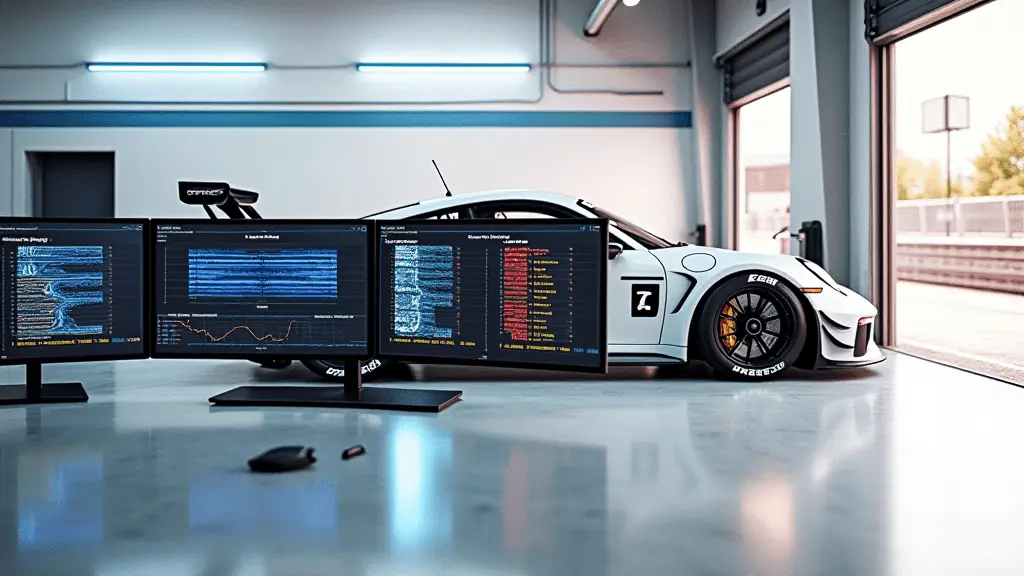You know that feeling when you absolutely nail a corner entry? Everything flows perfectly. The brake release feels smooth, the turn-in is precise, and the car rotates exactly how you want it. But here’s the thing: that feeling can be deceiving. I learned this lesson the hard way during my transition from the GT4 Clubsport to the GT3 Cup car.
I remember my first weekend at Laguna Seca in the new Cup car. I felt incredibly confident about my corner entries, especially into Turn 2, the Andretti hairpin. The car felt stable, I was hitting my marks, and everything seemed perfect. Then I looked at the data. The Cosworth traces told a completely different story. I was leaving nearly 8 mph of entry speed on the table because I was carrying my GT4 habits into a car with significantly more aero capability.
That weekend changed my entire approach to corner entry speed. I discovered that what feels fast often isn’t, and what feels scary is sometimes exactly what you need to do. The data logger became my most trusted coach, offering unbiased feedback that helped me push beyond my comfort zone safely and systematically.
Over the past few years, I’ve developed a data-driven approach to optimizing corner entry speed that has transformed my driving. Whether I’m attacking the carousel at Sonoma or diving into Turn 1 at COTA, every corner entry now starts with a clear understanding of what the data is telling me.
In this guide, I’ll share exactly how I use data logging systems to analyze and improve corner entry speed. We’ll look at real examples from tracks like Thunderhill and Road America, and I’ll show you how to interpret everything from brake pressure traces to G-force data. Whether you’re running a basic VBOX setup or a professional Cosworth system like in my Cup car, these techniques will help you find those crucial extra miles per hour at corner entry.
Let’s dive into the data and discover how to turn those squiggly lines into real-world speed.
Understanding Corner Entry Data
Let me tell you about a lightbulb moment I had while testing at Sonoma. I was reviewing data from the Carousel, comparing my GT4 laps to the Cup car, when I realized just how many different data channels work together to tell the complete story of corner entry. Let’s break down exactly what I’ve learned to look for.
Key Data Channels That Matter
First, let’s talk about brake pressure. This is your money channel for corner entry, and the Cosworth system in my Cup car provides incredibly detailed brake pressure traces. Here’s what I’m looking for:
- Initial brake application rate
- Maximum brake pressure achieved
- The shape of the brake release curve
- Any reapplication during trail braking
At Turn 11 at Sonoma, I discovered that what felt like a smooth brake release was actually a series of small stabs that were upsetting the car’s balance. The data showed me exactly where I needed to smooth out my inputs.
Speed Traces Tell the Truth
Speed traces are like truth serum for your corner entry technique. I remember analyzing my approach into Turn 2 at Thunderhill, convinced I was carrying good speed into the corner. The data painted a different picture:
- Initial brake point was consistent
- But I was over slowing the car by almost 12 mph
- The minimum speed point was happening way too early
- My exit speed suffered as a result
The Cosworth system lets me overlay these traces with reference laps, making it crystal clear where I’m leaving time on the table. This has been particularly valuable at technical corners like Turn 7 at Sonoma.
G-Force Data: Your Grip Budget
Understanding lateral and longitudinal G-forces has been crucial in maximizing corner entry speed. In the Cup car, the available grip is significantly higher than the GT4, thanks to the aero package. Here’s what I look for:
- Peak braking G-forces
- The transition from braking to cornering forces
- Combined G-force during trail braking
- Any unexpected drops in lateral G that indicate understeer
At COTA’s Turn 1, the G-force trace showed me I wasn’t taking full advantage of the aero grip available at high speeds. I was backing off too early, when the data showed the car had much more to give.
Steering Angle Insights
The steering angle trace often reveals issues you can’t feel in the car. Looking at my data from Laguna Seca’s Turn 2:
- Initial turn-in was too aggressive
- Mid-corner corrections were causing understeer
- Exit steering unwinding wasn’t smooth enough
By comparing steering angle traces with speed and G-force data, I’ve learned to identify exactly where I’m asking too much of the front tires and where I could be more assertive with my inputs.
Through analyzing thousands of laps across these different channels, I’ve developed a systematic approach to reading the data. But remember, these channels don’t exist in isolation. The real magic happens when you learn to interpret how they work together to paint the complete picture of your corner entry technique.
In the next section, I’ll show you exactly how I use this data to identify and correct common corner entry mistakes. Trust me, some of these might surprise you. I know they surprised me when I first saw them in my data.
Common Corner Entry Mistakes
After spending countless hours analyzing data from both my GT4 and Cup car sessions, I’ve identified some common corner entry mistakes that show up repeatedly in the data. Let me share what I’ve learned, particularly through my experience at some challenging corners.
The Andretti Hairpin Challenge at Laguna Seca
Let me tell you about my first weekend attacking the Andretti Hairpin (Turn 2) in the Cup car. This double-apex hairpin, with its dramatic downhill approach at high speed, quickly exposed every weakness in my transition from GT4 to Cup car. Here’s what the data revealed:
Initial Problem:
- Not using the full braking potential on the downhill approach (the Cup car’s aero meant I could brake later than I thought possible)
- Missing the first apex by trying to make it one smooth corner instead of treating it as a true double apex
- Over-slowing for the first apex (dropping to 45 mph when the car could handle 52)
- Poor throttle application between the apexes, losing crucial exit speed
The Cosworth data showed something fascinating. In the GT4, my more conservative approach worked well with the car’s mechanical grip and braking characteristics. But in the Cup car, I was:
- Not trusting the massive aero assistance during the initial braking phase
- Missing the optimal brake release point for the first apex
- Failing to maximize the transition between apexes
- Being too gentle with throttle application after the second apex
The Sonoma Carousel Revelation
The Carousel at Sonoma taught me another valuable lesson about corner entry. Looking at my data traces:
In the GT4:
- Early turn in was beneficial
- Gradual brake release worked well
- Conservative entry speed was fast
In the Cup car:
- Later turn in with more speed was significantly faster
- Sharp brake release actually helped rotation
- Higher entry speed was needed to maximize aero
The data showed me that what worked in one car could be completely wrong in another. This was a game changer for my approach to corner entry.
COTA Turn 1: The Commitment Corner
Turn 1 at COTA really exposed another common mistake in my driving. Here’s what the data revealed:
The Mistake:
- Initial brake point was good
- But I was lifting off the brakes too gradually
- Not carrying enough speed at turn in
- Missing the aero window for maximum grip
The Fix:
- Maintained harder braking longer
- More aggressive brake release
- Higher minimum speed
- Earlier throttle application
Thunderhill Turn 2: A Tale of Two Cars
Turn 2 at Thunderhill is this fantastic sweeper that really shows the difference between mechanical and aero grip. My data comparison revealed:
GT4 Technique:
- Early brake release worked well
- Gradual turn in was fast
- Progressive throttle application
Cup Car Reality:
- Later, harder braking was faster
- More aggressive turn in possible
- Earlier full throttle application needed
The Cosworth data showed that in the Cup car, I needed to completely reimagine my corner entry approach. What felt wrong was actually right.
The Universal Truth About Trail Braking
Across all these corners, the data consistently showed one thing: my perception of trail braking often didn’t match reality. The traces would show:
- Too much coasting between brake release and turn in
- Inconsistent brake pressure during trail braking
- Not using the full grip available during the transition phase
- Leaving speed on the table due to conservative brake release
Remember, these mistakes aren’t about being a bad driver. They’re about trusting what feels safe versus what the data shows is possible. Every time I find these patterns in my data, it’s an opportunity to get faster, to push the boundaries of what I think is possible.
Data-Driven Improvement Process
Let me share how working with a professional coach transformed my approach to data analysis and improvement. There’s nothing quite like having a reference lap from someone who can truly show you what’s possible in your car.
Setting the Real Baseline
My coach would head out early in the morning practice sessions when the track was clear. This wasn’t just about setting fast laps. It was about establishing what the car could truly do in those conditions. Here’s what made this approach so valuable:
- The baseline lap wasn’t theoretical. It was achievable in our car, on our tires, in those conditions
- Every brake point, every throttle application, every steering input was now a proven target
- The Cosworth data showed exactly how these targets could be achieved
Segment Analysis With Purpose
The real breakthrough came in how we used this baseline data. At Sonoma, for example:
Coach’s Approach:
- Later brake point into Turn 7
- Higher minimum speed through the Carousel
- Earlier throttle application out of Turn 10
My Learning Process:
- Compare my traces directly to the baseline
- Work on one corner at a time
- Focus on matching specific segments before trying to link it all together
Fast Lap vs. Baseline Comparison
At the Andretti Hairpin at Laguna Seca, the baseline lap showed:
- Brake point was 75 feet later than mine
- Initial brake pressure was significantly higher
- Quicker transition between the double apex
- Much earlier throttle application after second apex
This wasn’t guesswork anymore. The data showed exactly where I needed to improve, and I knew it was achievable because my coach had just done it in the same car.
Implementation Strategy
My coach helped me develop a systematic approach:
Morning Sessions:
- Review baseline data before going out
- Focus on one specific aspect at a time
- Come in after short runs to compare data
- Make incremental adjustments
Afternoon Progress:
- Begin linking segments together
- Push closer to baseline points
- Monitor consistency
- Review overall improvements
Real Example: Turn 2 at Thunderhill
- Coach’s baseline showed a much later brake point
- Higher minimum speed possible through the corner
- Earlier throttle application on exit
- Over two days, I closed the gap from 0.8 seconds to 0.3 seconds in just this corner
Progress Tracking
The Cosworth system made it easy to track my progress toward the baseline:
- Direct overlay comparisons
- Segment time analysis
- Speed differentials
- Brake and throttle application points
While I never quite matched my coach’s times, having that baseline was invaluable. It showed me what was truly possible in the car and gave me clear, achievable targets to work toward.
Software Tools and Analysis
Let me walk you through how we used the Cosworth system to make the most of the coaching process. The right software tools made all the difference in translating my coach’s expertise into tangible improvements on track.
### Cosworth Toolbox: Getting the Most from Your Data
The Cosworth system in my Cup car became our shared language for improvement. Here’s what made it so effective:
Math Channels We Used Most:
- Corner entry speed comparisons
- Brake release rates
- Combined G-loading
- Throttle position analysis
At Sonoma, we found the math channels particularly valuable in the Carousel. The data clearly showed where my coach was maintaining higher minimum speeds through sustained corners, allowing us to break down exactly what made the difference.
Overlay Techniques That Actually Work
Working with my coach, we developed specific overlay strategies:
- Synchronizing data at braking points
- Comparing corner entry phases
- Analyzing throttle application patterns
- Tracking steering inputs
I remember a breakthrough session at COTA. By overlaying my coach’s Turn 1 approach with mine, we could see exactly where I was leaving time on the table. The Cosworth system let us stack multiple channels, showing how brake pressure, steering angle, and throttle position all worked together.
Setting Up Meaningful Comparisons
We organized our data analysis around these key elements:
- Best lap overlays
- Segment time comparisons
- Corner entry speed analysis
- Brake and throttle traces
At Laguna Seca, this systematic approach helped us identify that I was consistently losing time in the transition phase of the Andretti Hairpin. The data showed my coach’s quicker transitions between the double apex, giving us a clear target to work toward.
Video Integration: Seeing is Believing
The Cosworth system’s video integration proved invaluable. Being able to watch my coach’s lines while seeing the corresponding data traces helped connect what I was seeing with what I was feeling in the car. This was particularly helpful at technical sections like:
- Turn 9 at Thunderhill
- The Carousel at Sonoma
- Turn 11 at Laguna Seca
Real-Time Analysis Between Sessions
Our approach between sessions was methodical:
- Download and review data immediately
- Compare to coach’s baseline
- Identify largest areas of time loss
- Create specific goals for next session
This immediate feedback loop helped us make the most of every track day, focusing our efforts where they would have the biggest impact.
The Power of Historical Data
Having my coach’s baseline data stored in the system gave us a constant reference point for improvement. We could:
- Track progress over multiple events
- Adjust for changing conditions
- Identify consistent patterns
- Build on previous successes
This historical perspective was crucial in understanding my development as a driver and making informed decisions about where to focus our efforts in future sessions.
Conclusion: Making Data Work for You
Looking back on my journey from the GT4 to the Cup car, I can tell you that mastering data analysis wasn’t just about understanding squiggly lines. It was about building confidence through concrete evidence of what’s possible.
The Cosworth system in my Cup car became more than just a data logger. Working with my coach, it became a window into understanding the true potential of both the car and myself as a driver. Those early morning baseline laps set by my coach weren’t just targets. They were proof that more was possible, that what felt on the edge could actually be well within the car’s capabilities.
Here’s what I’ve learned about making data work for you:
Start with Trust
The data doesn’t lie. When my coach showed me he could brake 75 feet later into the Andretti Hairpin, it wasn’t theory. It was fact. The car could do it. The challenge was building my confidence to match that capability.
Focus on Progress, Not Perfection
I never quite matched my coach’s times, but that wasn’t really the point. The data showed my progression, helped identify where to focus, and validated each step forward. Those tenths of a second gained at Sonoma’s Carousel or Turn 9 at Thunderhill came from methodical work with the data, not from trying to find everything at once.
Build on Success
Each small victory, validated by data, became a foundation for the next step. When I finally nailed the brake point at COTA’s Turn 1, the data confirmed it. That confidence carried over to other corners, other tracks, other challenges.
Keep Learning
The beauty of data analysis is that there’s always more to learn. Every session brings new insights. Every track offers new challenges. The Cosworth system keeps revealing new ways to understand what the car is doing and how to make it faster.
Let me leave you with this thought: Data isn’t just about finding speed. It’s about building confidence through understanding. Whether you’re running a basic VBOX or a professional system, the key is using that data to validate your progress and identify your next opportunity for improvement.
Remember, the fastest way around any track isn’t about heroic moments. It’s about understanding what’s truly possible and methodically building the skills to achieve it. The data is there to light the way. Trust it, learn from it, and use it to become the driver you want to be.





